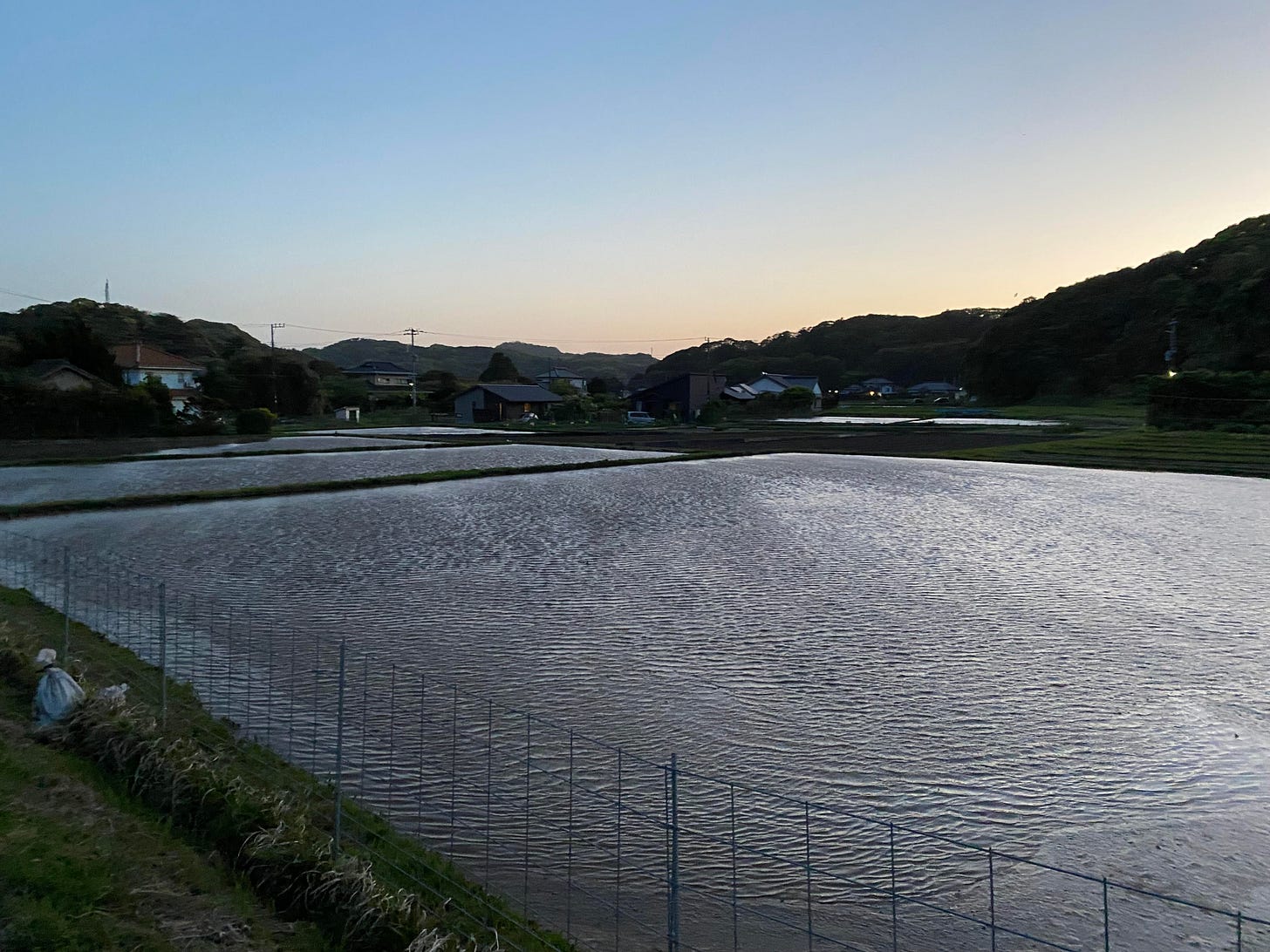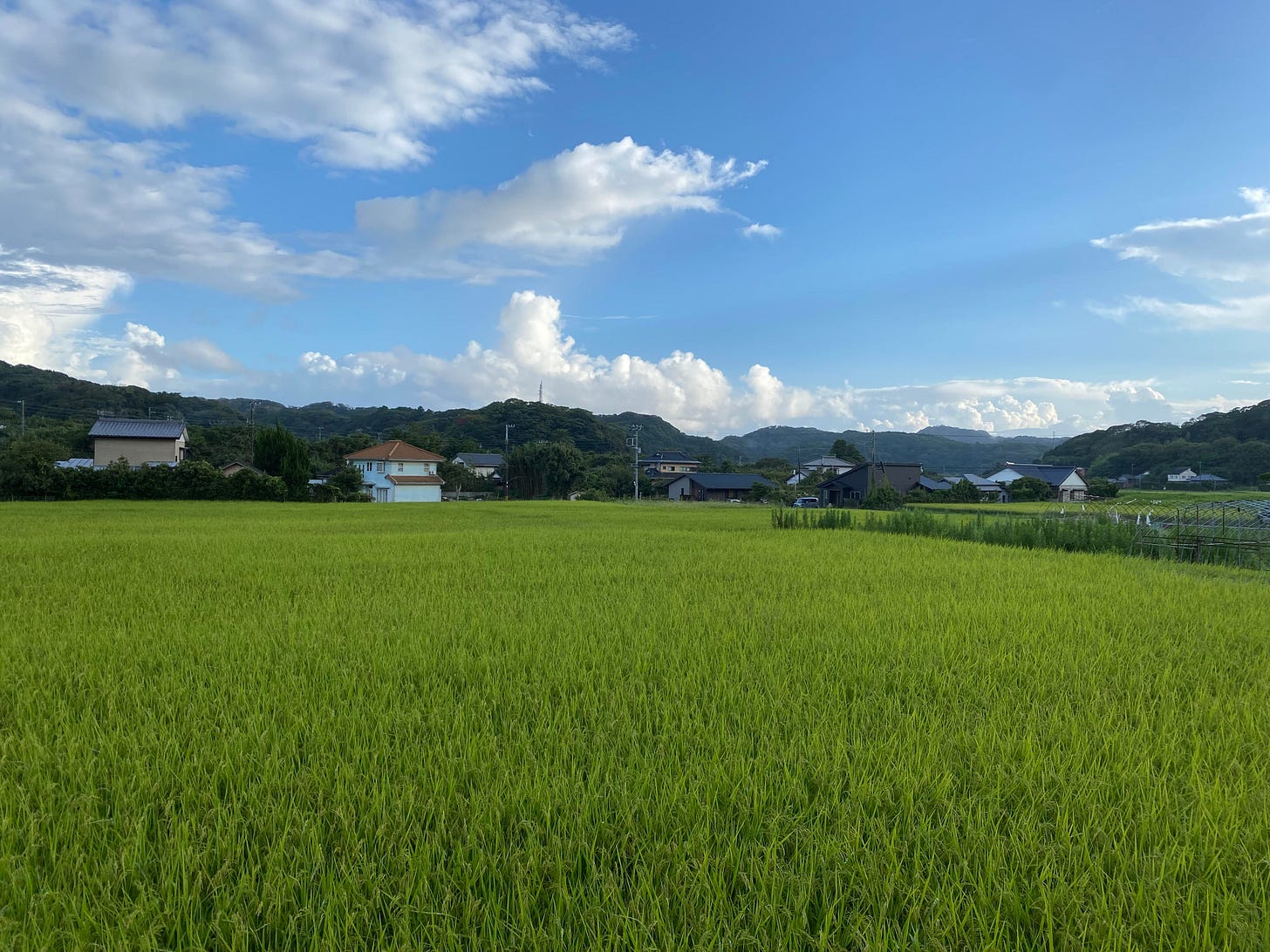Yuzo Yoshida is one of our valley’s last commercial rice farmers. Other families here still grow rice but largely for their own household consumption, rather than for scale purchase by the agricultural cooperative.
Yoshida-san is the third-born son and the only of his siblings to remain here to take care of his great great grandfather’s land. He has about 4 hectares of paddies—some of which are in further flung parts of the valley. On average for Japan, that land size will produce about 16 tons of unpolished rice a year.
I found him resting in some shade across from one of his plots a few evenings ago and struck up a conversation.
He explained that he was checking the stalks of this year’s rice to make a final decision when he’d try to book the cooperative’s (shared) combine for cutting and stripping the grain. “This year will be early,” he said. “Maybe by end of August we need to get all reaped because the summer has been hot and dry.” I asked him how he checked the stalks—did he pop out some grains and inspect by eye or is there another way? Yoshida said, “It’s all in the angle the inaho starts to bend downward with the weight of the rice grains.”
Fun fact and Japanese-language sidenotes:
Bending rice stalks have a specific name in Japanese. If it’s drooping, what you are looking at is no longer o-kome (rice) or ine (stalk) or any of another hundred names. The plant is now inaho… weighty rice, ready to cut soon. (It’s uber Japanese to assign different names to animals and food stuffs depending on stage of development.)
Maddening word games for the outsider, yes, but yet another instance when I realize that Japanese can be a truly beautiful language too.
Check this. In Tokyo, we have a small izakaya that’s called Inaho no Shizuku, which most literally means the dew on the sagging rice. I say literally because there’s actually layers of hidden meaning in the phrase. Morning dew on a stalk actually is a clever way of saying sake.
Yum. Now when I walk Terashima-kun in these late August mornings and I see dew pushing the stalks over, I think of clear ginjou sake.
The paddies farmed just for family use are cut by smaller-scale machinery that whacks the stalks and ties them quickly into large handfuls. Those groups of stalks are then gathered up and neatly hung out to dry in the sun on primitive wooden racks set up on the cleared field.
Yoshida-san however is commercial. There’s no way he could manage that kind of clearing and drying on his own, so a combine has arrived this morning to begin what looks like industrial-scale vacuuming of his fields. A single driver methodically “hoovers” row after row, felling thousands of stalks in each broad swoop. The machine cleanly gathers and runs the stalks down both sides of the vehicle until each disappears into a large storage vat on the back of the truck. Just as each stalk disappears into the back, the rice grains are stripped clean, separated, and deposited pure into a huge internal bin. The green detritus, the remaining 95% or so, is pulverized and simultaneously spit out below and behind the vehicle. This leaves just fresh, green compost behind for next year’s soil.
It’s amazing actually.
Yoshida’s grain haul he says is weighed before it’s dried, and he’s paid according to that take. The cooperative takes his fresh grain off to the processing facility for drying and for ultimate polishing depending on what grade of rice it will be sold as.
“Do prices (paid for your rice) fluctuate each year,” I asked. He laughed and said not enough, that’s for sure. Prices for grain types and for regions are decided top-down by agricultural boards and the government. There might be a bit of niggling along the way due to weather, pests, or any other unforeseen issues, but it’s negligible according to him.
And interestingly, all rice produced is guaranteed bought each year so there is little incentive to vary grains, rotate crops, or to innovate in any way. The name of the game for a family like the Yoshidas who depend on rice for an annual income is weight, and weight alone. Produce as much as your land can deliver.
Japanese commercial farmers are also hamstrung by an intense market demand for quality and purity. Crops are only sown once a year (other countries run two or more cycles on the same land) and rice is grown only from tested, high-quality seedlings, never by scatter seeding.
I asked Yoshida-san why so many of the families no longer produce commercially. “There’s really three reasons. Manpower—our kids move away. My two brothers and a sister all left decades ago and their kids sometimes visit on holidays but won’t be leaving the city anytime soon. Who wants to farm when they can earn more in the cities working a desk job? The second reason of course is Thailand, China, and so many other overseas producers now able to market here while charging much less.” Lastly, he says that the nation’s consumption of rice has been steadily declining.
I’ve told you how Toru and I have been laden several times with vegetables by our neighbors who can’t eat a quarter of what they produce each year. Most recently, a lady we don’t even know gave us two of the finest pumpkins we have ever eaten. Now we are silently hoping to get a sack of rice from a local. What moochers!
Tell you what. If we take down all those veggies, pumpkins, and even rice, hosting a neighborhood barbeque for those benefactors and more will become a must. Now that’s what I’d love to use Frog’s Glen for.








How did you become so interesting? I just summarized all this for my T
have u tried local one near your place ? Small shack off the road